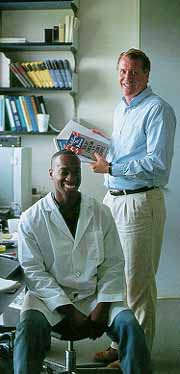
Samuel Ward, head of Molecular and Cellular Biology, with
MCB student David Hodge. Hodge, now a junior, began as a summer intern two years ago in
Ward's lab and has been studying the effects of different chemicals on sperm motility in C.
elegans, a microscopic round worm. Photo by Diane Schmidt.
|
 he Undergraduate Biology Research Program started modestly in 1988 with just 19
students and 13 faculty members. The program got by that first year with departmental
funds and faculty research grants, but in 1989, the Howard Hughes Medical Institute gave
the program a boost with a grant of $1.5 million, matched by $545,000 from the UA. In
1994, Samuel Ward, molecular and cellular biology department head, applied for and
received an additional $2 million from HHMI to fund the program for four years. Money from
both grants, as well as from the National Science Foundation and the American Society for
Pharmaceutical and Experimental Therapeutics, were also directed to the department’s
efforts to improve undergraduate education. With the additional funds, the department
began programs to recruit and train Native American students, to train high school science
teachers, and to carry on outreach programs for pre-college students. he Undergraduate Biology Research Program started modestly in 1988 with just 19
students and 13 faculty members. The program got by that first year with departmental
funds and faculty research grants, but in 1989, the Howard Hughes Medical Institute gave
the program a boost with a grant of $1.5 million, matched by $545,000 from the UA. In
1994, Samuel Ward, molecular and cellular biology department head, applied for and
received an additional $2 million from HHMI to fund the program for four years. Money from
both grants, as well as from the National Science Foundation and the American Society for
Pharmaceutical and Experimental Therapeutics, were also directed to the department’s
efforts to improve undergraduate education. With the additional funds, the department
began programs to recruit and train Native American students, to train high school science
teachers, and to carry on outreach programs for pre-college students.
The Howard Hughes Medical Institute was founded in 1953 by Howard R. Hughes. It has, as
its primary purpose and objective, “the promotion of human knowledge within the field
of the basic sciences, principally the field of medical research and medical education and
the effective application thereof for the benefit of mankind.” HHMI’s grants
program was established in 1987, and has become the largest private science education
effort in U.S. History, says President Purnell W. Choppin, M.D.
|

